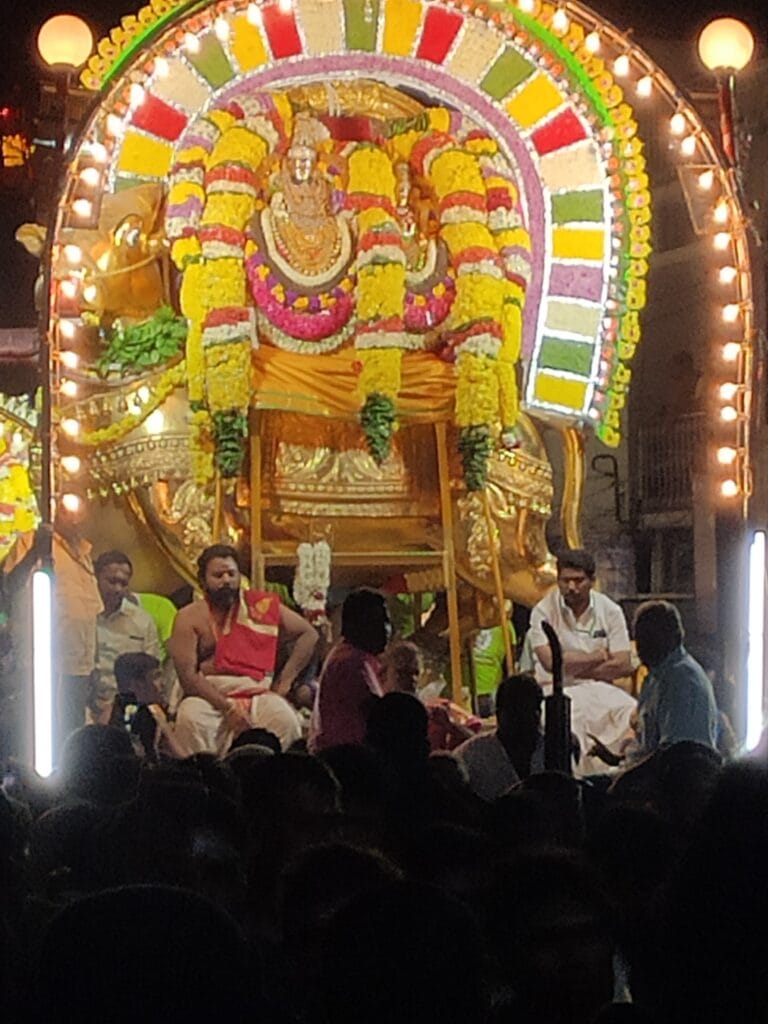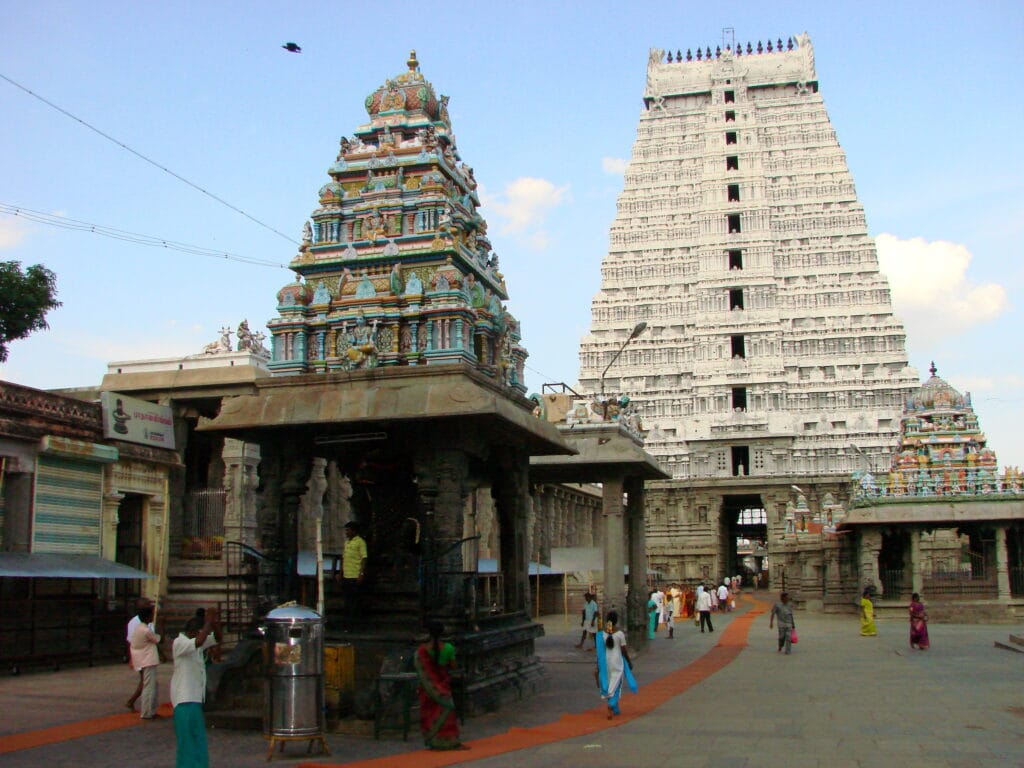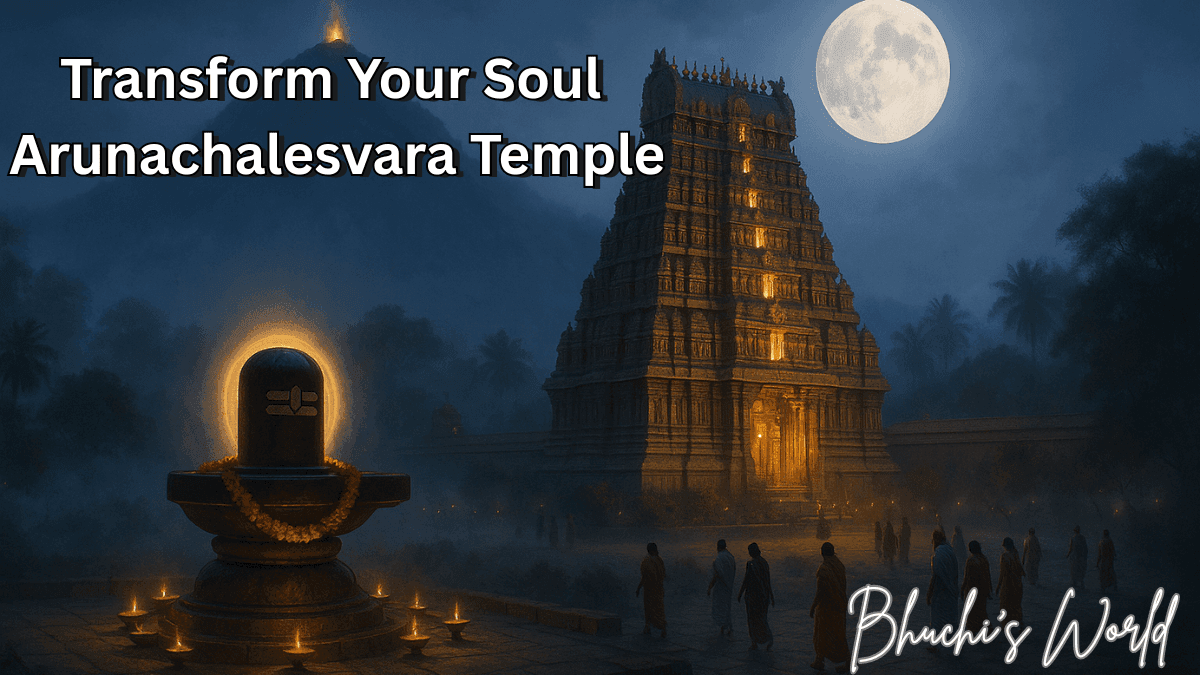You’re not just visiting a temple when you arrive at the Arunachalesvara Temple—you’re stepping into the eternal heart of divinity. Nestled at the base of the mighty Arunachala hill in Tiruvannamalai, Tamil Nadu, this sacred site is more than 2,000 years old. Revered as one of the five Pancha Bhoota Sthalas, representing the element of fire, this ancient shrine isn’t just a marvel of architecture—it’s a cosmic experience waiting to transform your life.
Whether you’re a spiritual seeker, a history enthusiast, or a curious traveler, this pilgrimage offers you a journey into inner silence, mysticism, and divine grace. From the mystical Girivalam walk under the full moon to the awe-inspiring Karthigai Deepam, each step you take is steeped in sacred vibrations. Let’s delve into the five most powerful experiences you’ll encounter here.
The Sacred Roots of Arunachalesvara Temple

The Legend of Agni Lingam
When you set foot in this hallowed ground, you’re entering the space where Lord Shiva is believed to have manifested as an infinite pillar of fire—Agni Lingam—to humble Lord Vishnu and Lord Brahma. This divine story isn’t just myth; it lives on in every inch of the temple’s massive stone corridors and shrines. You can feel it—the power, the humility, the cosmic balance.
The Lingam here symbolizes fire, transformation, and divine illumination. It isn’t just a stone structure; it’s a portal to a deeper dimension of your own spirit.
Historical Legacy and Dynasties
Built initially by the Chola dynasty and later expanded by Pandyas, Hoysalas, and Vijayanagara kings, the temple stands as a testament to South India’s spiritual and architectural brilliance. You’ll marvel at the inscriptions and sculptures that narrate tales of devotion and divine encounters, each telling you that faith here is timeless.
Even today, thousands gather daily, walking barefoot through its hallowed corridors, eyes closed in prayer, as they surrender their worries to something far greater than themselves.
Walking in the Divine Circle: The Girivalam Experience
When you set out barefoot under the glowing full moon to perform Girivalam around Arunachala Hill, you’re not just walking—you’re participating in a timeless spiritual act that thousands have done before you. This 14-kilometer circumambulation is a living, breathing prayer, a way to align your body with the cosmic rhythm.
Spiritual Meaning of Pradakshina
“Giri” means hill, and “valam” means going around. As you start the pradakshina from the temple, every breath you take and every step you walk draws you deeper into the sacred energy of Arunachalesvara Temple. It is believed that this act dissolves karma, awakens inner clarity, and reconnects you with your divine source.
What’s truly remarkable? You don’t have to chant mantras or perform elaborate rituals. Your silent devotion, your steady walk, and your focused mind—these become your prayer. You’ll pass by ancient lingams, small shrines, and holy tanks—all radiating the sacred power of Shiva.
Full Moon Nights and Their Power
The magic of Girivalam amplifies under the full moon. As the moonlight bathes the Arunachala Hill in a silvery glow, thousands join the walk—women in colorful saris, men in dhotis, and foreigners in simple robes. The atmosphere becomes electric with devotion. On these nights, the veil between the divine and the human feels incredibly thin.
The Girivalam calendar is packed throughout the year, but especially vibrant during Karthigai Deepam, Pournami, and Mahashivaratri. If you’re planning a visit, don’t miss these dates.
Festival of Lights: Karthigai Deepam at Arunachalam

Imagine this—you’re standing amidst thousands of devotees, your eyes turned toward the peak of Arunachala Hill. The sun has just set, and a mighty flame, Maha Deepam, bursts forth atop the mountain. The crowd erupts in chants of “Annamalaiyarukku Arohara!”—a thunderous wave of devotion echoing through the night sky. This is Karthigai Deepam, the most iconic festival at Arunachalesvara Temple.
Maha Deepam: Fire on the Mountain
Karthigai Deepam, usually celebrated in late November or early December (December 13th in 2024), symbolizes the divine appearance of Lord Shiva as an endless column of fire—the Agni Lingam. A massive cauldron is carried to the hill’s summit and filled with ghee and wicks. When lit, it becomes the Maha Deepam, visible for miles, representing Shiva’s infinite light.
You feel your heart swell as the flame appears. It’s not just a ritual—it’s a call from the cosmos, a reminder that light always overcomes darkness.
Rituals and Celebrations
The celebration begins ten days earlier with flag hoisting and processions of the temple’s deities in ornate chariots. During this time, the entire city of Tiruvannamalai becomes a canvas of oil lamps—lined across rooftops, windows, roads, and temple towers.
You’ll love the sense of unity. People from every walk of life—villagers, urban dwellers, international travelers—come together to light lamps and offer prayers. Even if you aren’t deeply religious, witnessing this collective devotion will touch your soul.
If you visit during this festival, prepare for packed streets, vibrant marketplaces, and a spiritual energy that’s unlike anything you’ve ever felt. Trust that this experience will stay with you for life.

Beyond the Temple: Spiritual Sanctuaries Around Arunachalam
When you think of the Arunachalesvara Temple, it’s easy to focus only on its towering gopurams and the sacred inner sanctum. But the divine energy of Arunachalam doesn’t stop at the temple walls. It expands far beyond, radiating through ancient ashrams, mystical caves, and silent retreats that dot the base of Arunachala Hill.
Ramana Maharshi Ashram and Inner Silence
Just a few minutes from the temple lies the Ramana Maharshi Ashram—a spiritual haven established by one of the most revered sages of modern India. When you walk through its gates, you’re immediately enveloped in stillness. No loud chants, no complex rituals—just an invitation to “Be still and know.”
You’ll sit in the meditation hall where Ramana Maharshi once taught. You may even walk to Skandashram and Virupaksha Cave, where he meditated for years. These caves, carved into the flanks of the Arunachala hill, are filled with an otherworldly silence that gently nudges you inward.
Thousands of seekers from around the globe come here for one thing—inner peace. Whether you meditate for five minutes or five hours, you’ll feel something shift. It’s subtle, but profound.
Siddha Caves and Mystic Vibes
Scattered around Arunachala are ancient caves used by Siddhars, enlightened beings known for their mastery over the body and mind. These aren’t tourist spots—they’re power spots. You’ll find places like Pavala Kundru, Guhai Namasivaya Cave, and the Seven Springs, where the air itself feels charged.
If you’re adventurous and spiritually inclined, a walk into these sites offers more than just panoramic views. They offer encounters with your own stillness, your own questions, and, maybe, even some answers.
Don’t forget to carry water, wear strong footwear, and, most importantly, approach these sites with respect. These are not historical relics—they’re living spaces of ancient wisdom.
Unlocking the Temple’s Energy: Architecture, Tanks, and Towers
While the spiritual aura of the Arunachalesvara Temple is intangible, its physical form is a masterpiece of devotion carved in stone. Every structure—be it the towering gopurams, ancient mandapams, or tranquil temple tanks—is charged with meaning and purpose. As you walk through this sacred space, you’re not just admiring architecture—you’re entering a living yantra of divine power.
Rajagopuram and Dravidian Grandeur
As you enter through the eastern gateway, you’re greeted by the majestic Rajagopuram—soaring nearly 66 meters high. Built by the Vijayanagara kings in the 16th century, this gateway is one of the tallest temple towers in India. Every tier is intricately adorned with stucco figures of deities, celestial beings, and mythical creatures.
But this is not merely a decorative tower. According to Agamic tradition, the gopuram acts as an energy filter, transitioning your worldly consciousness into a sacred mindset. You’ll feel it: the moment you step under its shadow, something shifts inside you.
The temple has four main gopurams and multiple smaller towers. Each one marks a cardinal direction, reinforcing the cosmic geometry of the complex.
Sacred Tanks and Symbolism
As you explore further, you’ll come across the enormous temple tank called Agni Theertham. It’s not just a place for ritual baths—it symbolizes purification. Pilgrims take a dip here before entering the inner sanctum, symbolically washing away negativity.
Inside the temple complex, there are additional tanks like Brahma Theertham and Shivaganga. These waters are believed to carry healing vibrations. Simply sitting near them—especially during sunrise or sunset—can be incredibly calming.
Every element here serves a higher function. Stone corridors are aligned with astronomical precision. The mandapams (pillared halls) echo with centuries of chants. The inner sanctum, where the Agni Lingam resides, radiates heat even during cool evenings—a testimony to the legend that Shiva manifests here as fire.
Practical Information for Pilgrims
Your spiritual journey to Arunachalesvara Temple becomes even more fulfilling when you’re well-prepared. Knowing when to go, what to wear, and how to conduct yourself inside the temple ensures your experience is both comfortable and deeply respectful of its sacred traditions.
Temple Timings and Darshan Hours
The temple opens early and closes late, welcoming thousands of visitors each day. Here’s the general schedule:
- 🕓 Morning Opening: 5:30 AM
- 🕘 Morning Puja & Darshan: 6:00 AM – 12:30 PM
- 🕔 Evening Opening: 3:30 PM
- 🕕 Evening Puja & Darshan: 4:00 PM – 9:30 PM
It’s best to arrive early in the morning or during evening pujas for a quieter, more meditative experience. On full moon days and during festivals, the temple can be exceptionally crowded—plan extra time accordingly.
Dress Code and Etiquette
Respecting local customs is a sign of devotion. When visiting, keep these in mind:
- Modest Dress: Men should wear dhotis or pants with shirts; women should wear sarees, salwars, or long skirts with tops.
- Footwear: Remove shoes and socks before entering the temple premises.
- Silence is Sacred: Avoid loud conversations, and maintain a reverent demeanor.
- Photography: Generally prohibited inside sanctum areas. Follow signage and temple staff instructions.
Make sure your mobile phone is on silent mode. Also, avoid carrying leather items such as belts and wallets into the inner sanctum if possible.
How to Reach Arunachalesvara Temple
The temple is located in the town of Tiruvannamalai, Tamil Nadu, well connected by road and rail:
- 🚆 By Train: Tiruvannamalai Railway Station is 2 km from the temple. Regular trains run from Chennai, Madurai, and Vellore.
- 🚌 By Bus: Buses from Chennai (190 km), Vellore (80 km), and Bengaluru (200 km) are frequent and economical.
- 🚗 By Car: National Highways 77 and 66 provide good access. Parking is available, but limited during festivals.
If you’re traveling during a festival or full moon night, make hotel and transport arrangements well in advance.
Nearby Attractions and Accommodations
Your journey to Arunachalesvara Temple isn’t confined to its majestic compound. Tiruvannamalai and the surrounding region offer a variety of sacred sites, peaceful retreats, and welcoming places to rest. Whether you’re staying for a night or immersing yourself for weeks, you’ll find that every corner of this town echoes with devotion.
Places to Visit Around Arunachalesvara Temple
- 🧘♂️ Ramana Maharshi Ashram
Just a short walk from the temple, this ashram is ideal for silent meditation, spiritual reading, and introspection. - 🪨 Skandashram & Virupaksha Cave
Located partway up Arunachala Hill, these serene caves are where Ramana Maharshi spent years in deep meditation. The trek is moderate and well worth it for the views and peace. - 🏞️ Seshadri Swamigal Ashram
Another saint who lived in Tiruvannamalai, Seshadri Swamigal is known for his compassionate energy. This peaceful ashram is open to all. - 🌅 Yogi Ramsuratkumar Ashram
A newer but equally vibrant spiritual center dedicated to “The Godchild of Tiruvannamalai.” The evening bhajans here are especially uplifting. - 🔥 Arunachala Hill
The very hill that Shiva is said to have manifested as fire. A climb to the summit (if physically possible) is a spiritual milestone in itself.
Where to Stay and Eat
Tiruvannamalai caters to all types of visitors—from wandering sadhus to international tourists. Accommodation ranges from simple dharmashalas to boutique ashrams and mid-range hotels.
- 🏨 Recommended Stays:
- Sparsa Resort (3-star, eco-friendly)
- Hotel Arunachala (great temple views)
- Ramana Towers (close to the ashram)
- Shree Krishna Residency (budget-friendly)
- 🍲 Where to Eat:
- Aakash Inn and Saravana Bhavan (vegetarian South Indian meals)
- Dreaming Tree Café (continental and vegan options)
- Local tea stalls near the temple (great for quick refreshments and observing local life)
During major festivals, rooms fill up quickly—so book well in advance. Many ashrams also offer lodging, especially for those staying longer for sadhana or meditation retreats.
Upcoming Festivals and Events at Arunachalesvara Temple in 2025
The Arunachalesvara Temple in Tiruvannamalai is renowned for its vibrant festivals that draw devotees from across the globe. These events offer profound spiritual experiences and a glimpse into the rich cultural tapestry of the region. Here’s a guide to the major festivals and events scheduled for 2025:
🪔 Karthigai Deepam – December 4, 2025 (Thursday)
Karthigai Deepam is the most significant festival celebrated at Arunachalesvara Temple. On this day, a massive beacon is lit atop Arunachala Hill, symbolizing Lord Shiva’s manifestation as an infinite pillar of fire. The ten-day festival culminates in this grand event, attracting thousands of devotees who witness the Maha Deepam from various vantage points around the hill.
🌕 Pournami Girivalam Dates
Girivalam, the sacred circumambulation of Arunachala Hill, is especially auspicious on full moon (Pournami) nights. Devotees undertake this 14-kilometer walk barefoot, seeking spiritual benefits and inner peace. Here are the Pournami dates for 2025:
- January 13, 2025 (Monday): Starts at 5:04 AM
- February 11, 2025 (Tuesday): Starts at 6:55 PM
- March 13, 2025 (Thursday): Starts at 10:35 AM
- April 12, 2025 (Saturday): Starts at 3:21 AM
- May 11, 2025 (Sunday): Starts at 8:01 PM
- June 10, 2025 (Tuesday): Starts at 11:35 AM
- July 10, 2025 (Thursday): Starts at 11:35 AM
🎉 Chithirai Vasantha Utsavam – May 2–11, 2025
This ten-day spring festival celebrates the divine union of Lord Arunachalesvara and Goddess Unnamulai Amman. The festivities include elaborate processions, special abhishekams (ritual baths), and cultural programs. Devotees gather in large numbers to participate in the celebrations, which are marked by devotion and joy. 🌸 Chitra Pournami – May 12, 2025 (Monday)
Chitra Pournami is a significant full moon day observed with special rituals and Girivalam. The full moon is believed to have a powerful spiritual influence, and devotees perform the circumambulation seeking blessings and spiritual upliftment.
🕉️ Maha Shivaratri – February 26, 2025 (Wednesday)
Maha Shivaratri, the “Great Night of Shiva,” is observed with night-long vigils, special pujas, and Girivalam. Devotees fast and engage in prayers, seeking the blessings of Lord Shiva for spiritual growth and liberation.
Conclusion: Embrace the Flame Within
As you leave the sacred grounds of Arunachalesvara Temple and glance back at the towering Rajagopuram or the distant flame atop Arunachala Hill, you realize something profound—you haven’t just visited a temple, you’ve walked through a living embodiment of divine fire.
This isn’t a destination. It’s a transformation.
From the quiet introspection of Girivalam to the thunderous devotion during Karthigai Deepam, every experience at this sacred site is a call to awaken the divine flame within you. Whether you come seeking peace, answers, or the grace of Lord Shiva himself, Arunachalesvara Temple opens a door—not just to the divine—but to your own higher self.
So when you’re ready, come barefoot. Come open-hearted. Come as you are.
Because at Arunachalam, Shiva doesn’t just reside in stone or fire—He resides in your silence, your stillness, and your surrender.
Om Arunachaleswaraya Namah.
Read More on Bhuchisworld
Discover more from Bhuchi's World
Subscribe to get the latest posts sent to your email.

